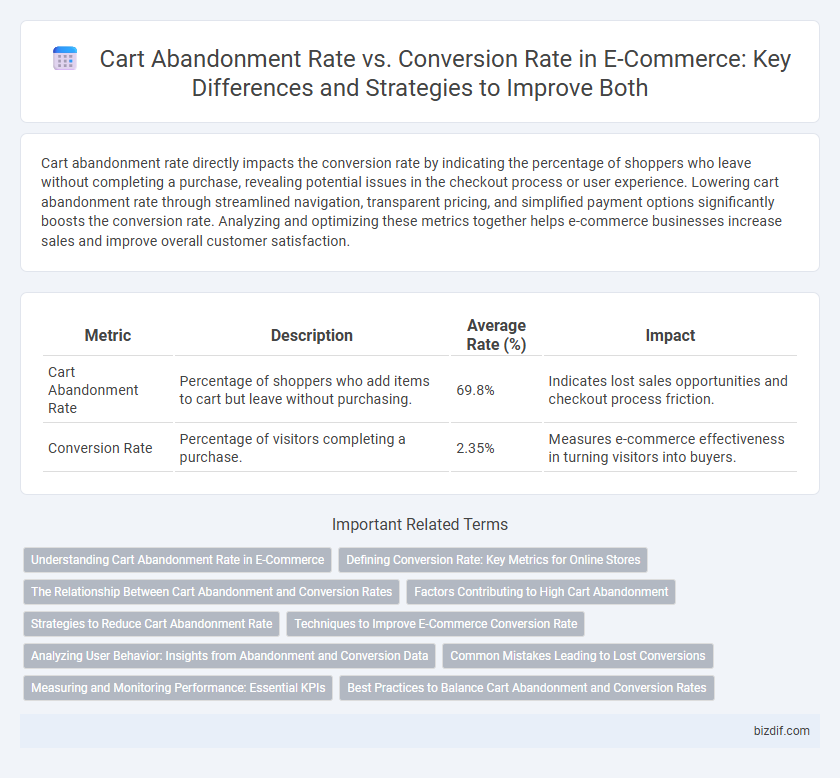Cart abandonment rate directly impacts the conversion rate by indicating the percentage of shoppers who leave without completing a purchase, revealing potential issues in the checkout process or user experience. Lowering cart abandonment rate through streamlined navigation, transparent pricing, and simplified payment options significantly boosts the conversion rate. Analyzing and optimizing these metrics together helps e-commerce businesses increase sales and improve overall customer satisfaction.
Table of Comparison
| Metric | Description | Average Rate (%) | Impact |
|---|---|---|---|
| Cart Abandonment Rate | Percentage of shoppers who add items to cart but leave without purchasing. | 69.8% | Indicates lost sales opportunities and checkout process friction. |
| Conversion Rate | Percentage of visitors completing a purchase. | 2.35% | Measures e-commerce effectiveness in turning visitors into buyers. |
Understanding Cart Abandonment Rate in E-Commerce
Cart abandonment rate measures the percentage of online shoppers who add products to their cart but leave the website without completing the purchase, often influenced by factors such as high shipping costs, complicated checkout processes, or lack of payment options. Understanding cart abandonment rate helps e-commerce businesses identify friction points that hinder conversions and enables targeted strategies like retargeting emails, streamlined checkout designs, and personalized offers. Reducing cart abandonment directly improves conversion rate, which reflects the percentage of visitors completing a purchase, ultimately increasing revenue and customer retention.
Defining Conversion Rate: Key Metrics for Online Stores
Conversion rate measures the percentage of online store visitors who complete a desired action, such as making a purchase, and is calculated by dividing the number of conversions by total site visitors. Key metrics for evaluating conversion rate include the average order value, customer acquisition cost, and cart abandonment rate, which directly impacts overall sales performance. Optimizing these metrics helps e-commerce businesses improve user experience, reduce cart abandonment, and increase revenue.
The Relationship Between Cart Abandonment and Conversion Rates
High cart abandonment rates directly impact e-commerce conversion rates by reducing the percentage of visitors who complete purchases. Optimizing the checkout process and addressing common barriers like unexpected costs or complicated forms can lower abandonment and boost conversion. Understanding the correlation between cart abandonment and conversion rates enables businesses to implement targeted strategies that improve overall sales performance.
Factors Contributing to High Cart Abandonment
High cart abandonment rates in e-commerce are predominantly driven by unexpected shipping costs, complicated checkout processes, and lack of payment options. Slow website load times and insufficient trust signals, such as security badges, further discourage customers from completing purchases, negatively impacting conversion rates. Addressing these factors can significantly reduce abandonment and boost overall sales performance.
Strategies to Reduce Cart Abandonment Rate
Reducing cart abandonment rate directly improves e-commerce conversion rate by ensuring potential buyers complete their purchases. Effective strategies include simplifying the checkout process, offering multiple secure payment options, and providing clear shipping information and costs upfront. Implementing retargeting campaigns and exit-intent pop-ups with special discounts can also recapture hesitant shoppers and increase conversion rates.
Techniques to Improve E-Commerce Conversion Rate
Reducing cart abandonment rate directly boosts e-commerce conversion rate by streamlining checkout processes, offering multiple payment options, and providing clear shipping information. Personalized retargeting emails and exit-intent popups recover potential lost sales by reminding customers of incomplete purchases. Implementing trust signals such as customer reviews and secure payment badges enhances consumer confidence, increasing successful transaction completions.
Analyzing User Behavior: Insights from Abandonment and Conversion Data
Analyzing cart abandonment rates alongside conversion rates reveals critical user behavior patterns, highlighting moments of hesitation and friction within the purchase journey. High abandonment rates coupled with low conversion rates often indicate issues such as complex checkout processes, unexpected costs, or lack of trust signals. Leveraging this data allows e-commerce businesses to optimize user experience, streamline checkout flows, and implement targeted retargeting strategies that increase overall conversion rates.
Common Mistakes Leading to Lost Conversions
High cart abandonment rates often stem from common mistakes such as complicated checkout processes, unexpected costs, and lack of trust signals, which directly reduce conversion rates. Failing to optimize mobile experiences and neglecting personalized follow-up strategies further exacerbate lost conversions in e-commerce. Addressing these issues through streamlined navigation, transparent pricing, and targeted retargeting campaigns significantly improves conversion outcomes.
Measuring and Monitoring Performance: Essential KPIs
Cart Abandonment Rate and Conversion Rate are crucial KPIs for measuring e-commerce performance, indicating the percentage of users who leave without purchasing versus those who complete transactions. Monitoring these metrics enables businesses to identify friction points in the checkout process and optimize user experience to increase sales. Regular analysis of abandonment reasons and conversion trends, combined with targeted interventions, drives improvements in overall revenue and customer retention.
Best Practices to Balance Cart Abandonment and Conversion Rates
Optimizing the checkout process with clear calls-to-action and simplified forms reduces cart abandonment rate while enhancing conversion rate. Implementing personalized retargeting emails and offering limited-time discounts can effectively recover lost sales and boost completed purchases. Leveraging real-time analytics to identify drop-off points enables targeted improvements that balance customer experience and maximize overall e-commerce revenue.
Cart Abandonment Rate vs Conversion Rate Infographic

 bizdif.com
bizdif.com